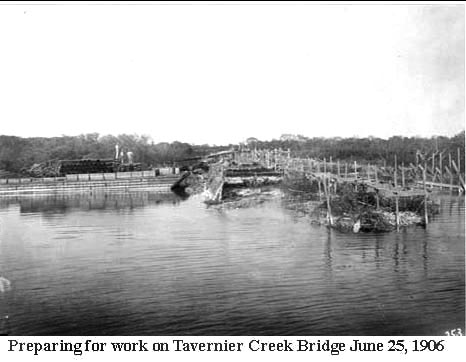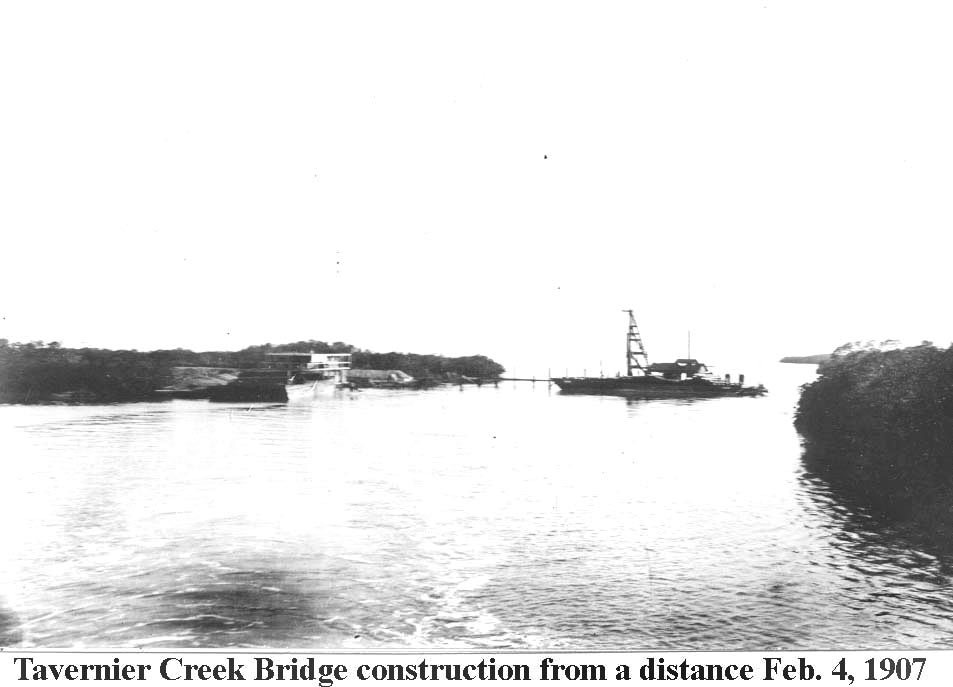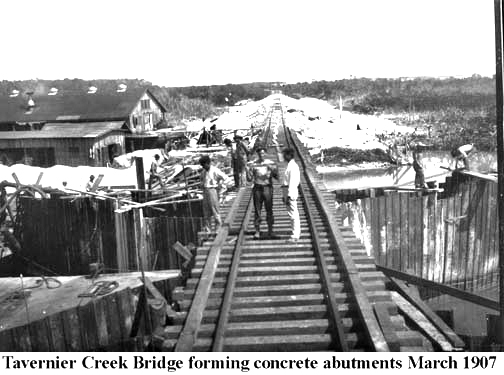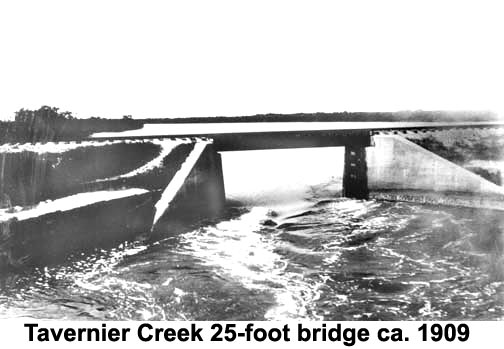Building the railroad that Went to Sea with photos.
Page 4
Building small non concrete railroad bridges.
The majority of railroad bridges
built were the arch type concrete bridges. Many shallow water passages
between islands were simply filled in with a wide causeway without even
a culvert. Knight's Key, Hog Key and Key Vaca in Marathon are examples.
Today, with the passage of time they appear as one island.
Flowing creeks and selected smaller water
passages had basically a causeway with a 50-foot wide bridge near the center.
These are the subject of this page and Tavernier Creek is used as there
are enough dated photos to show the approximate evolution.
Access across Tavernier Creek, Snake Creek
and Whale Harbor was needed for construction train access; however, floating
concrete plants number 1 and 2 were just now being completed in Miami.
All bridge openings required wave deflecting concrete abutments; therefore,
the Indian Key Fill bridges were also waiting. Channel 2 and Channel 5
bridges were first built of wood until the arch bridge technology, primarily
the concrete plants, was in place.
 The above image is looking north. Railbeds are
being prepared for the barging in of locomotive number 10 in November 1906.
With the powerful rolling stock equipment, crossties, tracks and ballast
stone can be quickly put in place. On scene is a quarterboat for housing
and the pile driver. The dredge Babcock
has already dredged out
the ocean and bay entrances for the deeper draft boats. Tavernier Creek
was a navigable waterway by this date. The October 17, 1906 hurricane delayed
progress considerably before the next photo.
The above image is looking north. Railbeds are
being prepared for the barging in of locomotive number 10 in November 1906.
With the powerful rolling stock equipment, crossties, tracks and ballast
stone can be quickly put in place. On scene is a quarterboat for housing
and the pile driver. The dredge Babcock
has already dredged out
the ocean and bay entrances for the deeper draft boats. Tavernier Creek
was a navigable waterway by this date. The October 17, 1906 hurricane delayed
progress considerably before the next photo.
 The above and below photos are both dated the
same day, February 4, 1907. Not shown, the excavator Mikado had
"thrown up" fill for the approachments and in another photo is shown working
at Snake Creek in September 1906.
The above and below photos are both dated the
same day, February 4, 1907. Not shown, the excavator Mikado had
"thrown up" fill for the approachments and in another photo is shown working
at Snake Creek in September 1906.
 A lot of progress
has taken place in about a month and a half between these two photos. For
one reason, it is winter, steam powered equipment, less mosquitoes and
more workers.
A lot of progress
has taken place in about a month and a half between these two photos. For
one reason, it is winter, steam powered equipment, less mosquitoes and
more workers.
 The above bridge is announced as open in newspapers
and probably was for the lightweight "Ten Spot" construction locomotive.
Note the relatively large buildings to the left. These buildings were moved
along with progress.
The above bridge is announced as open in newspapers
and probably was for the lightweight "Ten Spot" construction locomotive.
Note the relatively large buildings to the left. These buildings were moved
along with progress.
The concrete wave deflecting abutments is
being poured, but no doubt the bridge was being used for light work. Baldwin
side dump cars will fill in the space around the wood piling which were
left in place. Marl was used as a top finishing coat.
 This photo is of poor quality, but serves to depict
the small opening for ocean and bay water transfer. These were blamed for
the huge tidal surge backup of seawater in the 1935 Hurricane.
Work continues and now let's move to constructing
the arch bridges.
This photo is of poor quality, but serves to depict
the small opening for ocean and bay water transfer. These were blamed for
the huge tidal surge backup of seawater in the 1935 Hurricane.
Work continues and now let's move to constructing
the arch bridges.
|